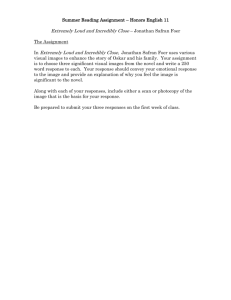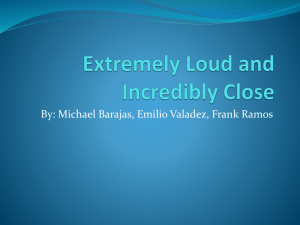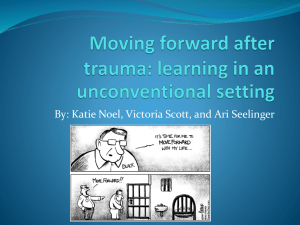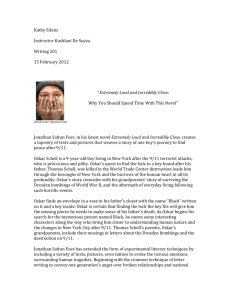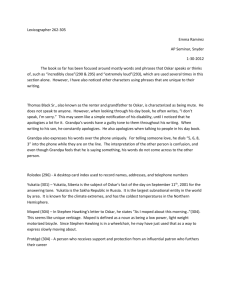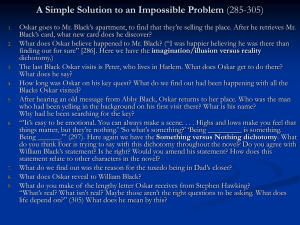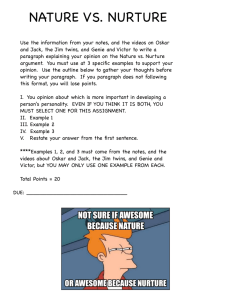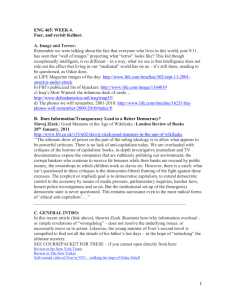Kostyukovsky_ResearchPaper
advertisement
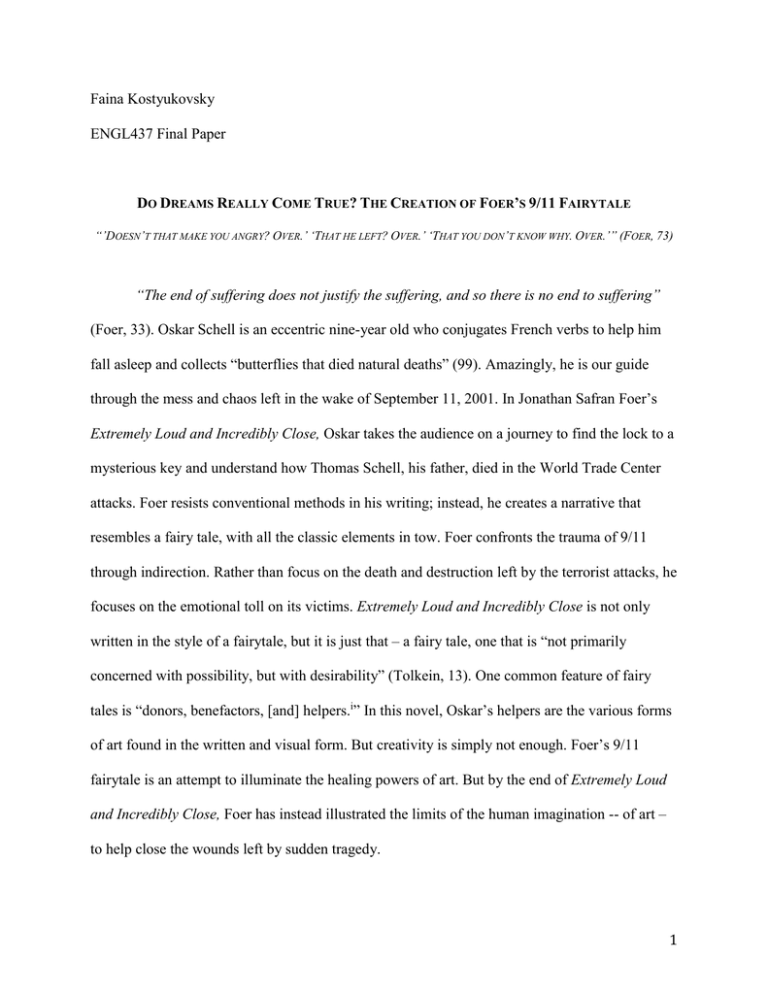
Faina Kostyukovsky ENGL437 Final Paper DO DREAMS REALLY COME TRUE? THE CREATION OF FOER’S 9/11 FAIRYTALE “’DOESN’T THAT MAKE YOU ANGRY? OVER.’ ‘THAT HE LEFT? OVER.’ ‘THAT YOU DON’T KNOW WHY. OVER.’” (FOER, 73) “The end of suffering does not justify the suffering, and so there is no end to suffering” (Foer, 33). Oskar Schell is an eccentric nine-year old who conjugates French verbs to help him fall asleep and collects “butterflies that died natural deaths” (99). Amazingly, he is our guide through the mess and chaos left in the wake of September 11, 2001. In Jonathan Safran Foer’s Extremely Loud and Incredibly Close, Oskar takes the audience on a journey to find the lock to a mysterious key and understand how Thomas Schell, his father, died in the World Trade Center attacks. Foer resists conventional methods in his writing; instead, he creates a narrative that resembles a fairy tale, with all the classic elements in tow. Foer confronts the trauma of 9/11 through indirection. Rather than focus on the death and destruction left by the terrorist attacks, he focuses on the emotional toll on its victims. Extremely Loud and Incredibly Close is not only written in the style of a fairytale, but it is just that – a fairy tale, one that is “not primarily concerned with possibility, but with desirability” (Tolkein, 13). One common feature of fairy tales is “donors, benefactors, [and] helpers.i” In this novel, Oskar’s helpers are the various forms of art found in the written and visual form. But creativity is simply not enough. Foer’s 9/11 fairytale is an attempt to illuminate the healing powers of art. But by the end of Extremely Loud and Incredibly Close, Foer has instead illustrated the limits of the human imagination -- of art – to help close the wounds left by sudden tragedy. 1 In Extremely Loud and Incredibly Close, Foer adopts the literary tradition of fairy tales to construct Oskar’s narrative. Up until the nineteenth century, “fairy tales were never meant for children” and “were conceived of as adult entertainment” (Cashdan, 6). Because fairy tales originated for an older audience, the content of the stories was darker. In fact, “many early fairy tales include[d] exhibitionism, rape, and voyeurism” (6). In order to appeal to “less literate audiences,” the fairytales were simplified, and a younger crowd became intrigued by the magical and fantastical elements of these stories. But the modern fairytale is still no light fare. On the contrary, they are “serious dramas that reflect events taking place in the child’s inner world” (10). Fairytales tend to address the truths of reality in the form of an exciting and enthralling adventure story. At first, the story may seem attractive simply because of “its ability to enchant and entertain” but what really makes fairy tales so popular is their “power to help children deal with the internal conflicts they face in the course of growing up” (10). As Oskar points out, “it probably gets pretty lonely to be anyone” (Foer, 69). It’s hard to keep moving when it feels as if the world is working against you. In Extremely Loud and Incredibly Close, Oskar has just lost his father in 9/11 and must cope with the guilt of ignoring his father’s last phone call and the overwhelming sadness from losing a parent. Oskar’s narrative has all the classical elements of a fairy tale. Oskar has to “’somehow’ find a passage into a beyond” and so, the honest and sensitive hero, the “all-American Kid” must set out on a quest (Ingersoll, 55; Versluys, 101). He is searching for specific answers about his father’s death and until then, “life is […] frozen in suspension that demands resolution” (Heuver, 26). He is kind, with good intentions, and is very clever for his age. Along the way, Oskar touches on “universal truths” and exposes human weakness, and has a tendency to hyperbolize, all common elements of the protagonist, or “good character” in fairy talesii. Just as Cinderella 2 loses her beloved father in the classic fairy tale, Oskar loses his father, who is “reminiscent of the idealized father figure” (Ingersoll, 55). Through the use of magical and fantastical devices, “Oskar falls, in a way, under the spell of the key,” a spell so out of the ordinary that Oskar proclaims, “if it weren’t my life, I wouldn’t have believed it” (Heuver, 26; Foer, 151). Oskar has a noble goal, one that the audience can easily accept and relate too – the search for meaning behind his father’s death. Of course, Oskar faces obstacles – there’s never a direct route to “happily ever after.” The villain in the novel, however, is more elusive. The 9/11 terrorist attacks serve as a backdrop of Extremely Loud and Incredibly Close. Oskar’s enemy is not the same enemy as the United States Government. Rather, “the novel concentrates not on the painful presence of the dark power, but on its painful outcome” (Heuver, 25). The enemy is not a physical entity but the “painful outcome” of 9/11: Oskar’s suffering. Oskar embarks on a quest, where he must undergo some type of transformation to fulfill “the fundamental impulse underlying the human urge for storytelling” that, “in the end, ‘light overcomes the darkness’” (Heuver, 25). As humans, even in time of great suffering, we hold on to the hope that good will prevail, if not in the immediate present, then in the long-term. The overwhelming burden of not knowing is the problem. Oskar cannot live with the unknown: “it gave me heavy boots that [Grandma] had nightmares, because I didn’t know what she was dreaming about and there was nothing I could do to help her” (Foer, 104). Oskar wants to know everything there is to know about the world around him, an impractical goal. In order for Oskar to move beyond his father’s death and “defeat” his enemy, he must accept the “darkness” as part of him and learn how to control it. The most important fairy tale-like plotline in the novel is its prolific use of art. Just like Dorothy had a Scarecrow, a Tin Man, and a Cowardly Lion and Cinderella had a fairy 3 godmother, Oskar has his grandfather’s camera, his fantastic and colorful imagination, and the power of writing to accompany him on his quest for the lock. The images inserted into the narrative of Extremely Loud and Incredibly Close are part of Oskar’s scrapbook, Stuff That Happened to Me, a method employed to “[help] [Oskar] hold things together” while the rest of his life seems to be falling apart (Paton, 16). These images – photographs and drawings, business cards and the design of a paper plane – are proof of his travels, of the places he’s been, the people he’s met, and the things he’s seen. Oskar takes photographs continuously throughout the novel so there is evidence that he existed in that particular moment of time. For Oskar, “the immediacy generated by these images seems to cater to a […] desire for direct witnessing” – something that, in relation to 9/11, was impossible (Siegel, 4). The pictures serve as sad reminders for Oskar and readers alike that we can never know exactly what happened on 9/11. We can only get “incredibly close” to the details but we “can’t make the impossible possible” (Foer, 169). In Oskar’s fairytale, he collects artifacts of his life so that in case of another tragedy, art will provide more than a coping mechanism, but a tangible answer. Because Oskar cannot understand how his father died, he begins to imagine it. But his imagination does not stop there. Oskar begins to invent things that could protect people from disappointment, from sadness and heartbreak and all the evils in the world, like “a pocket that could hold the universe” or water that would change your skin color to match your mood (Foer, 74). His imagination allows for him to plan for the future, something that he was unable to do before 9/11. He creates a drain under every person’s pillow that would lead to a reservoir so that everyone’s tears will be trapped in one central location, and “when something really terrible happened – like a nuclear bomb, or at least a biological weapons attack – an extremely loud siren would go off, telling everyone to get to Central Park to put sandbags around the reservoir” (38). 4 Oskar’s vivid imagination acts as a distraction from reality. Although there was no way to predict 9/11, if Oskar can preemptively fight off future tragedy, then no one will have to suffer as he was forced to anymore. Oskar employs different means of writing to work through his grief. He writes letters to people he’s never met, like Stephen Hawking and Jane Goodall. He describes his performances as the character Yorick in Hamlet, a play (which in itself, is another art form as well). Unsurprisingly, Oskar’s imagination takes a hold and he writes a scene in which he strays from his script and beats up Jimmy Snyder, his enemy in elementary school. Not only does he physically beat him to a pulp, but “THE AUDIENCE is applauding, all of them, because [he is] making so much sense” […] They call out, “Thank you! Thank you, Oskar! We love you so much! We’ll protect you!” (Foer, 146). Through writing, he can voice his sentiments without restraint. In a class presentation, Oskar uses a recording of an interview with a mother whose daughter died when the U.S. dropped the atomic bomb on Hiroshima. Although the audience cannot hear the interview, Oskar transcribes it in the text. The mother, Tomoyasu, said “She died in my arms, saying ‘I don’t want to die.’ That is what death is like” (189). By repeating this story of another survivor, Oskar attempts to find solace in collective empathy. Yet, the interview serves as another reminder of mankind’s flaws and incredulous inability to learn from the past. The art of writing allows Oskar to detail his deepest emotions without always explicitly defining them. He expresses his sadness over the loss of a father by trying to reach out to his role models, to serve as “replacements” for his father. He illustrates his frustration of being misunderstood by changing the lines in a class play where his courage is recognized and where everyone understands him and supports him. And, he uses a radio recording of an interview to point to his feeling of already knowing what “death” feels like – living without your most loved one. When 5 Oskar does blatantly admit to his feelings, his words are written in all caps for extreme emphasis on the intensity of his anger and frustration: “BUT STILL I WANT HER TO ASK ME HOW I GOT THEM (EVEN THOUGH SHE PROBABLY KNOWS), AND TO FEEL SORRY FOR ME (BECAUSE SHE SHOULD REALIZE HOW HARD THINGS ARE FOR ME), AND TO FEEL TERRIBLE (BECAUSE AT LEAST SOME OF IT IS HER FAULT), AND TO PROMISE ME THAT SHE WON’T DIE AND LEAVE ME ALONE” (173). The use of all capitalized letters imitates the act of yelling at the reader. But the reader understands that we are not Oskar’s targets, nor is he yelling at his mother. His anger is directed at his father for abandoning him, for not saying “I love you” in his last message, for leaving him alone without warning or explanation. Within Oskar’s narration is his father’s own fairy tale, The Sixth Borough. The story starts out hopeful, just as Extremely Loud and Incredibly Close does. Storytelling has long been an oral tradition where fairy tales are passed down from one generation to the next. The act of storytelling is an intimate and personal experience. The moment that Oskar and his father share is Oskar’s “favorite moment” (Foer, 13). It’s the beginning of something – a promise of “something incredibly wonderful” (12). When Oskar has doubts about the existence of the Sixth Borough, his father provides “sound” scientific proof. After all, “another way of looking at it would be, how could you ever be wrong?’” (9). However, the Sixth Boroughers’ attempt to keep the floating island attached is futile, but “of course they tried to save it” (219). Nevertheless, in the end, the fate of the Sixth Borough is the fate of Oskar, and every other victim of 9/11 trying to understand what happened: childish perseverance in an attempt to prolong the inevitable – acceptance of the unknown. The Sixth Borough is another sad reminder that art, in this case, a 6 fairy tale, is just a “mosaic of [our] dreams,” of “things we’ve lost […] and what we want to come” (221, 222). Foer attempts to recreate the intimate art of storytelling between Oskar and the reader to bring us together in shared empathy. But, the story turns out to be “a tragic recognition that well intentioned as they may be, our efforts […] always come up short of our desires and expectation” (Ingersoll, 65). Even in the story of the Sixth Borough, a story that may or may not be true, there is no charmed ending. As much as Oskar enjoyed the story, he recognizes its improbability. When the other students are making fun of his grandmother at his performance of Hamlet, Oskar “wished the two of [them] could go somewhere far away, like the Sixth Borough.” (144). This desire assumes that the Sixth Borough exists outside reality – a fairy tale in the human imaginations to take Oskar out of the present and allow him to escape to a “neverland” of sorts. Furthermore, it serves as a reminder of the failure of art to bridge the gap between what we already know and what we want to know. It’s easy to look at the facts of 9/11 and point to the statistics – our society is obsessed with presenting us with facts, numbers, and the specifics of the day. Yet, our curiosities are intangible. Oskar is forced “to remember the life that [he] didn’t want to lose but lost and [has] to remember” (109). The story of the Sixth Borough reminds him that the “true lies elsewhere” and art cannot take him there (Ingersoll, 65). Somewhere between his visit to Aaron Black and William Black, the “once upon a time” and “happily ever after” becomes lost in a sea of disappointments and failures. In Foer’s story, there is no happy ending. When Oskar finds out that the key belongs to William Black, he is no closer to understanding his father’s death than he was when his journey began. Oskar was doomed from the start of his journey, “for the key to unlock the lock would be for Oskar to inhabit the moment of his father’s death, to understand the logic of that traumatic instant” 7 (Huehls, 87). At first, the audience believed in Oskar and his goal: it is human instinct to try to deconstruct tragedy with logic and reasoning. But, “9/11 [was] so sublimely horrific […][that] no amount of inventing, symbolizing, or accruing can possess that central emptiness (88). Oscar’s imagination allows him to escape the present briefly, but he cannot hide behind his inventions. Our greatest regret becomes “how much [we] believed in the future” (Foer, 281). In Oskar’s writing, he invites the readers into his world. His writing is colored by emotion – “sadness, happiness, anger, love, guilt, joy, shame, and a little bit of humor” (201). The audience allows Oskar to unburden himself on us in hopes that if he can talk through he feelings, he can conquer the undesirable ones. If Oskar can use the art form of writing to unleash his burden, he can leave all the sadness behind, knowing he has told his story. The photographs allow Oskar to document his life in his scrapbook, Stuff That Happened to Me with souvenirs of the past. At the time the photograph was taken, Oskar had no idea how his present would turn out and how it would affect his future. According to Freud, “because consciousness cannot absorb the traumatic event in the moment of the occurrence, the time of the original event inflects all future times” (Huehels, 79). Any effort to understand tragedy at the moment of its occurrence is wasted. The search for meaning will persist for the rest of one’s life. The use of writing, photography and manipulation of text, a vivid imagination, and scribbles and red markings, temporarily alleviates the pain by allowing Oskar to speak and create without limit. Conversely, our hero’s investment in art as means of healing isolates him from the present. Oskar lives in a daydream and just like his Dad, Oskar “sometimes missed the forest for the trees” (Foer, 43). Rather than focus on the moving present, Oskar is stuck in the “what ifs” of the past, the “could haves,” “should haves” and “would haves” of 9/11. Up until the very end, Foer’s novel makes use of different forms of art. The very last pages 8 of Extremely Loud and Incredibly Close contain a makeshift flipbook, where the falling man is actually flying up to safety. The reversal of time illustrates the power of art to represent the impossible and allow us to visualize our deepest hopes and desires. But, “the novel [still] ends up in a tragic mood because time cannot be reversed […] because rewinding happens only on TV or as a visual trick, because Oskar can be very smart but his father cannot be brought back to life” (Rodriguez, 60). Oskar is reluctant to accept his ignorance, but is resigned to do so regardless. The villain of this fairy tale is no longer the enemy, because the trauma has now become ingrained in the hero’s character. According to Heuver, “in fairy tales, there is the idea that the ‘villain must be rightfully punished and the hero must be victorious’” (25). There can be no victory, as the pain will be part of Oskar for the rest of his life. In Oskar’s story, he can accept what happened only because he has to – he is still alive, and his father is dead. Sadly, in the end, we come to the realization that “the language we use and the way we tell stories obscures the sad fact that most of the time no one understands what anybody else is saying” (Lambert). Art, in all its forms, in its infinite ability to add color to the everyday, to push us to the limits of our understanding and guide us through the dark corners of our existence, can only provide fleeting relief. In Extremely Loud and Incredibly Close, Foer recognizes the temporal nature of art. As we get older, the fairy tales of our childhood become increasingly less convincing. We are jaded and worn-out, told to limit our idealism to prevent disappointment. The resulting cautious optimism is precisely why, according to J.R.R. Tolkien, Oskar cannot succeed with art as his “helpers.” In his novel, Foer “makes a Secondary World which your mind can enter. Inside it, what he relates is ‘true:’ it accords with the laws of that world. You therefore believe it, while you are, as it were, inside. The moment disbelief arises, the spell is broken; the magic, or rather art, has failed” (12). As soon, as the reader, and Oskar, learns of the real 9 meaning behind the key, the potential for a “happy ending” is lost. Foer wrote Oskar’s story as a fairy tale to highlight his, and our, childish naiveté. Oskar is only nine, and while tragedy has struck him at a very young age, he still remains very ignorant. The reader, along with Oskar, has “lost count of the disappointments” and resigns himself to the knowledge that “we [c]ould have been safe” (Foer, 107, 326). At the very end of Oskar’s narrative, he attempts to reverse time so that his life can move from “the end to the beginning, from ‘I love you’ to ‘Once upon a time…’” (Foer, 326). The fairytale of Extremely Loud and Incredibly Close operates outside the boundaries of traditional fiction and blurs the line between reality and fantasy as means to bring us closer to the aftermath of tragedy. Oskar’s attempts to get closer to his father’s untimely death with the help of art are honest and admirable -- our society operates on the ability to think through things rationally. Art can guide us in the right direction, but leaves us right before we reach understanding. Oskar’s search, as well as any fairy tale, is just an example of wishful thinking. In the end, Oskar is still left with “the need for transparency in a world that has gone suddenly murky” (Versluys, 103). The only solution? Allowing his eyes to adjust to the dark. 10 WORKS CITED Cashdan, Sheldon. The Witch Must Die: How Fairy Tales Shape Our Lives. New York: Basic, 1999. Print. Codde, Philippe. "Philomela Revised: Traumatic Iconicity in Jonathan Safran Foer’s Extremely Loud & Incredibly Close." Studies in American Fiction 35.2 (2007). Print. Collado-Rodriguez, Francisco. "Trauma, Ethics and Myth-Oriented Literary Tradition in Jonathan Safran Foer's Extremely Loud and Incredibly Close." Journal of English Studies 5-6: 47-62. "The Elements of a Fairy Tale." Valerie Gokturk's English. Web. <http://www.surfturk.com/mythology/fairytaleelements.html>. Foer, Jonathan Safran. Extremely Loud and Incredibly Close. Print. Heuver, Esther E. Trauma and Rebirth: The Dynamics of Plot in Foer's Fiction. Thesis. 2008. Huehls, Mitchum. Qualified Hope: A Postmodern Politics of Time. Columbus: Ohio State UP, 2009. Ingersoll, Earl G. "One Boy's Passage, and His Nation's: Jonathan Safran Foer's Extremely Loud and Incredibly Close." The CEA Critic 71.3 (2009): 55-66. Lambert, Josh. "The World According to Oskar." 26 Mar. 2004. Paton, David. "The Imagistic Text in Jonathan Safran Foer: Tracing Unconventional Texts from Kerouac to the Artist’s Book." De Arte 81 (2010). Print. Siegal, Elisabeth. "“Stuff That Happened to Me”: Visual Memory in Jonathan Safran Foer’s Extremely Loud & Incredibly Close." Current Studies of Postgraduate Studies. Tolkien, J. R. R. The Monsters and the Critics, and Other Essays. Boston: Houghton Mifflin, 1984. Versluys, Kristiaan. Out of the Blue: September 11 and the Novel. New York: Columbia UP, 2009. i ii "The Elements of a Fairy Tale." Valerie Gokturk's English. Web. <http://www.surfturk.com/mythology/fairytaleelements.html>. "The Elements of a Fairy Tale." Valerie Gokturk's English. Web. <http://www.surfturk.com/mythology/fairytaleelements.html>. 11
